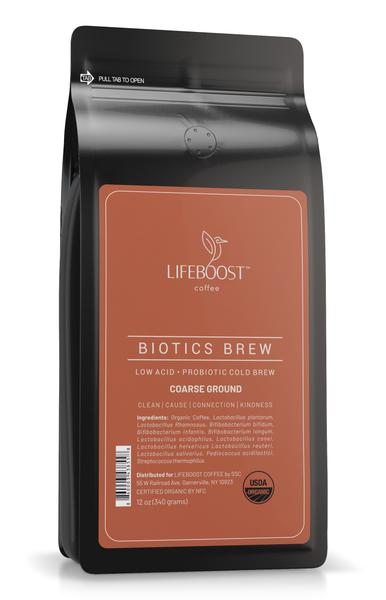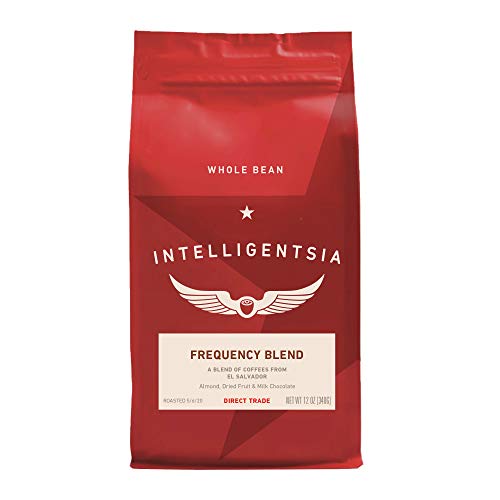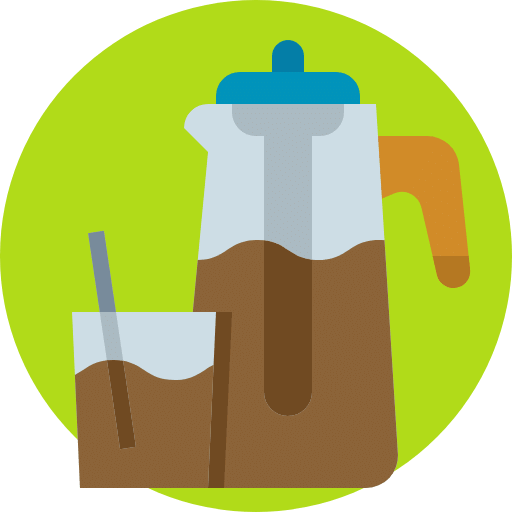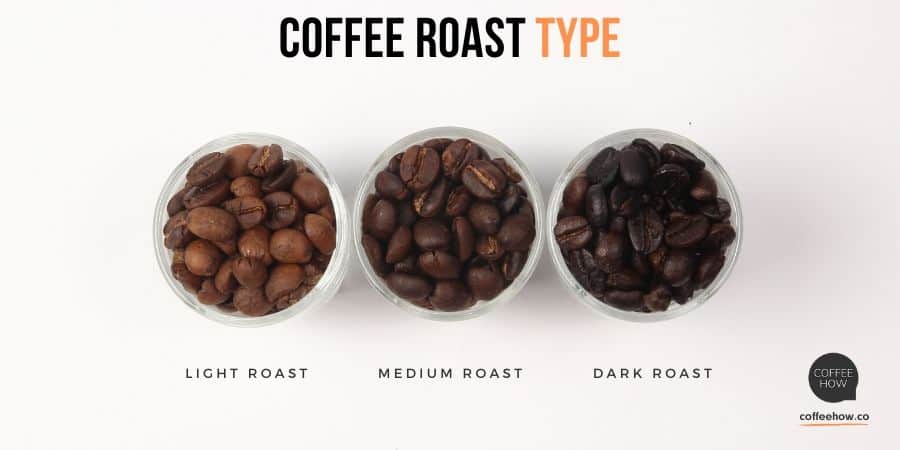Getting the Perfect Ratio When coffee tastes right, it is a joy to drink. The…
I was excited when my local coffee drive-through started selling cold brew. But then I took my first sip.
It was awful. Why? It came from a can! While I’m sure plenty of coffee shops brew their own cold brew and serve it fresh, that experience turned me off of the whole trend.
Then I learned how incredibly easy (and cheap) it is to make cold brew at home. This article is the result of our search for the best coffee for cold brew. If you keep a few simple things in mind, you too can make delightful cold brew at home.
Below you’ll find reviews of our top 10 best coffee beans for cold brew. Some are specially blended and pre-ground for cold brew. Others are simply coffees that are well-adapted to the cold brew method. Most of these are a medium roast, while three have a dark roast.

Lifeboost is all about presenting a healthier coffee. All of their coffee is GMO-free, pesticide-free, and USDA organic. They take the extra step of having a 3rd party lab test for mycotoxins. And their coffee is low acid. Take this low-acid coffee and cold brew it and you just might kiss tummy-troubles good-bye.
But wait! There's more! (Seriously, there really is.) Lifeboost adds a proprietary probiotic blend to make the coffee even better for your tummy. The patented formula can withstand the stomach acid to deliver the probiotic where you need it. In addition to improving gut health, probiotics may also boost the immune system and ease inflammation.
Lifeboost Coffee is shade-grown at elevation in Central America. It delivers bold flavor with a clean finish. This coffee comes pre-ground extra coarse. Toss it in whatever container you use for cold brew and add water.

Stone Street's Cold Brew Reserve is a 100% arabica Colombian Supremo. Colombian coffee is known for its bold flavor with fruity notes. Stone Street is a roaster located in Brooklyn. Its business practice is based on the fair and ethical treatment of coffee farmers. This commitment shows in their partnership with Sweet Unity Farms.
Cold Brew Reserve is dark roasted. Even if you don't typically like a dark roast, you might love it in a cold brew. This method reduces bitterness and gives a smooth infusion. In the cup, this coffee is sweet and well-balanced. Flavor notes include chocolate and caramel. While you can use any brewing method, these beans perform especially well as a cold brew.
You can get this coffee as whole bean or ground. The grind is extra coarse, the perfect size for cold brewing at home.

Bizzy does cold brew coffee. That's it. They focus on one thing and do it very well. The Minneapolis-based company started with two guys making cold-brewed coffee in their garage.
The company not only wants to deliver great coffee, but it wants to make a positive impact on the world while doing so. All its coffee is ethically sourced from Central and South America. The coffee is organic and non-GMO. Even the packaging is BPA-free and recyclable.
While any of their coffees are good for cold brew, we chose their Smooth & Sweet variety. This medium-roast coffee is a blend of 100% arabica beans from Guatemala, Peru, and Nicaragua. The brew is, well, smooth and sweet with notes of caramel and hazelnut.
You can buy this coffee pre-ground to use with any cold-brewing method. For ultimate convenience, Bizzy puts their cold brew coffee grounds into pitcher packs. Use any container, plop in a pack, add water, and forget about it until the next day. Simply pull out the pack and your cold brew is ready to enjoy. They also make a pre-brewed coffee concentrate that's available in 32-ounce bottles.

Here's another dark roast that made our list. Koffee Kult got its start in 2010. This small, family-owned business has one goal: sourcing the best coffee beans for the best cup of coffee. The company offers single-origin and blends roasted in small batches.
Koffee Kult also cares about the coffee farmers. It only does business with producers who pay women directly and equally. It also insists on working with farmers who respect the environment and use sustainable methods.
This blend features beans from Colombia, Guatemala, Brazil, and Sumatra. It delivers a strong, bold cup of coffee with a heavy body. It is smooth with a clean finish. Flavor notes include cinnamon and cocoa. Koffee Kult only sells their coffee as whole bean.

When I first heard the name of this coffee, I thought it means that the coffee had extra caffeine. But I was wrong.
The name actually comes from the physical location of the original Stumptown Coffee Roasters. They had taken over an old salon. The previous occupant left a sign that said "Hair Bender." So, they took that name for their first blend.
This medium roast coffee is clear but complex with notes of citrus and dark chocolate. The brew is sweet and balanced. The beans are sourced from Indonesia, Latin America, and Africa. As a company, Stumptown values sustainability. They pioneered the Direct Trade model.
You can buy this coffee ground, but it is a regular grind. We recommend buying this as whole bean and grinding it yourself.

Coffee Bros. focuses on importing micro-lots of coffee. They pay attention to each step from green bean to delivery to you. They ship the green beans via GrainPro to the roasters. This keeps the coffee beans from absorbing any harsh smells, moisture, or mold on their journey.
As a company, Coffee Bros. believes in the ethical treatment of farmers and has a commitment to helping their environment. It donates 1% of its revenue to One Tree Planted.
The beans from this blend are from Ethiopia and Brazil. They underwent natural processing, which enhances their sweetness. Varieties include Ethiopian Heirloom, Yellow Catuai, and Red Catuai. This medium roasted coffee is sweet and smooth. Tasting notes include dark chocolate, berry, and brown sugar.
Coffee Bros. roasts each batch to order. This helps ensure that the coffee you receive is as fresh as possible.

Kicking Horse Coffee started 25 years ago in the Canadian Rockies. It was named one of the best places to work in Canada! The company only uses 100% certified Organic and Fairtrade Arabica beans. This blend is also kosher and shade-grown.
The company definitely has a sense of humor. The packaging says this coffee is cheeky, bright, and precocious.
The beans for the Smart Ass blend hail from Africa and Central and South America. The medium roast coffee yields an aroma of sweet syrup, vanilla bean, and stone fruit. Tasting notes include tart red currant along with notes of sugar cane and milk chocolate. It has a honeyed berry body in your cup.

Intelligentsia traces its origin back to Chicago in 1995. The owners were pioneers in direct trade with farmers and paying a fair price for the coffee. They travel extensively and form deep and lasting relationships with coffee growers around the world.
Frequency Blend combines beans from Brazil and Guatemala. Varieties include Bourbon, Catimor, Caturra, and Catuai. We should note that the blend may change seasonally to take advantage of the coffee cherries at their peak of ripeness. But they carefully maintain the overall qualities in the cup.
Primary attributes are almond, dried fruit, and milk chocolate. The flavor profile also includes molasses. This medium roast coffee provides a balanced brew with a smooth body. It's offered as whole bean and 11 different grinds, including a coarse grind for the cold brew method. As with all their coffee, Frequency Blend is Direct Trade certified.

Cooper's Cask Coffee was founded to provide a better barrel-aged coffee. But what is barrel-aged coffee? It's coffee aged in a used whiskey, rum, or wine barrel.
Aged coffee is not the same as old, stale coffee. When coffee is aged in used casks, it takes on unique characteristics. You can actually taste the difference between coffees that were aged in whiskey, wine, or rum barrels!
This company's biggest concern is providing a thoroughly satisfying coffee. It cups every lot it imports to ensure it's up to its high standards.
Cooper's has now branched out into single-origin coffees. That brings us to this Organic Peruvian coffee. The roasters chose coffee beans and honed the roast method to be well-suited for cold-brewed coffee. This medium roast coffee has bold flavor in a well-balanced brew. Flavor notes include caramel, cherry, and orange. It comes in whole bean or a coarse ground perfect for any cold-brewing method.

If you're only in it for the caffeine buzz, then check out Death Wish Coffee. They are the world's strongest coffee. They do this by including robusta beans in the mix.
You may be thinking, "Robusta! Surely it can't taste good." But it does. The Specialty Coffee Association categorized Death Wish coffee as a specialty roast or gourmet blend. Under certain growing conditions, even robusta beans can taste good.
The beans in Death Wish coffee come from India and Peru. This coffee has a dark roast. The roasters use a strategic roasting plan to preserve the caffeine and maximize flavor. It's dark, but not bitter.
Flavor notes for Death Wish coffee include cherry and chocolate. You can feel good about buying Death Wish coffee. It is Fair Trade and USDA Organic Certified.

Cold brew coffee is simply coffee made with cold water instead of hot water.
This may seem like a trivial difference. But this method completely changes which elements you extract from the bean.
The difference between hot and cold-brewed coffee is similar to the difference between sun tea and traditionally brewed tea that is iced. The cold brewing method of sun tea gives a smoother, sweeter tea. And the cold brewing method of coffee gives a smoother, sweeter coffee.
The hot water extracts certain flavor compounds that cold water can’t. The extraction difference can be good or bad. You lose the light, fruity tones. This is also referred to as brightness. But you also lose the bitterness. You’ll have a deeper, richer brew. Cold brew has a heavier mouthfeel and a fuller body. Cold brew also highlights the nutty, chocolate, and spice notes.
Time. It takes a lot of time.
While hot water extracts the desirable qualities in a matter of seconds or minutes, it takes many hours to properly get a cold brew coffee. The colder the water, the longer the brew time. When brewed in the refrigerator, you’ll want to leave it for about 20 to 24 hours. You can cut the time almost in half when brewed at room temperature.
The easiest way to make cold brew coffee is to throw some coffee grinds in a container, add water, and let it sit. After it brews, you need to filter the coffee. We’ll detail this method later. Many coffee companies offer their cold brew coffee grounds in a pouch or packet. That way, you don’t have to worry about filtering the coffee. Just pull out the pouch and you’re done.
You can also brew the coffee in a French press. After the proper brew time, gently press the plunger down. Then pour the coffee in a container so it doesn’t over-extract.
You can also use a slow-drip method for cold brew. Some may refer to this as a Japanese method. You typically need a drip tower, which is a rather large, extravagant contraption. Water is suspended above the coffee grinds and drips out slowly. The water picks up the flavor as it passes through the grounds, then eventually drips out the bottom into a carafe. Proponents say this delivers a fuller cup of coffee, but it does require an investment and you need substantial counter space.
Some electric coffee makers have a cold brew setting. These use warm water instead of hot. This method holds the grounds and warm water in the brew basket. After 10 to 15 minutes, you release the brewed coffee into a carafe. While it’s not a true cold brew, it does provide many of the qualities that draw coffee lovers to cold-brewed coffee.

Not every coffee is suited for the cold brew method.
Some coffees that do well when hot brewed may not be the best coffee beans for cold brew. In this section, we’ll go over basic principles when choosing a coffee to cold brew. With the right coffee, you can take advantage of this easy and cheap method that yields an excellent cup of Joe.
In general, you want to go with a medium to dark roast. Hot water extracts acids and solubles that cold water can’t. This includes the components that yield the lighter fruity notes. If you like light roasted coffee for those qualities, then you may not enjoy cold-brewed coffee. That light roast that you love when hot brewed may taste muted or muddy as a cold brew.
Most of the coffees on this list are medium roasts. But dark roasts also do well with this brew method. Cold brewing brings out those deep flavor notes that darker roasts excel at. Many people don’t like the bitterness that can come from a dark roast. The beauty of cold brew is that it leaves the bitterness in the grounds. Even if you don’t usually like a hot dark roast, you may want to try a dark roast that is cold brewed.

Many single-origin coffees are lightly roasted to retain the unique flavor of coffee from that region. But the acidity and other subtle flavors don’t come through in a cold brew. For that reason, we’d say to stay away from single origin.
However, there are a number of single-origin coffees that make an outstanding cold brew. Coffee from regions known for its chocolate tones do very well with cold brew. This would include Sumatran and other Indonesian coffees, Columbian, Peruvian, and some Kenyan or other African coffees. Perhaps more important is choosing a medium or dark roast.
You’ll find a lot of blends that are specifically chosen for the cold brew method. These blends will have a well-rounded taste that is satisfying.
We always recommend you buy freshly-roasted whole bean coffee and grind it yourself immediately before use. However, that’s not always practical or possible. In those circumstances, a pre-ground will do. But not just any pre-ground.
A regular grind does not typically perform well in a cold brew. It can get over-extracted. But worse, the straining process can let undesirable solids into your final cup. While a mouthful of grinds in a hot cuppa is not pleasant, it’s even worse in a cold coffee.
Luckily, many cold brew blends are available in a coarse grind. If you don’t have a high-end coffee grinder, you may be better off choosing a pre-ground coffee designed specifically for cold brew.
All you need to make cold brew at home is water, coffee, a container, and a way to strain the grounds. For this recipe, we’ll use a one-pint mason jar. You can watch this video to see how this method works along with some tips.
To strain the coffee, you can use a kitchen strainer lined with cheesecloth. You can also use a 2-step method. First, strain through a fine strainer. Then, use a coffee filter in a cone basket to get a clear, clean coffee.
Using ice in a cold brew can dilute the flavor. To keep the strength, you have three options.
First, you can make ice cubes out of coffee instead of water.
Second, you can use ‘reusable ice.’ These are made of metal or plastic. You keep them in the freezer, then pop them into your drink to get ice cold coffee without ice.
Third, you can get a mold to make a large ball of ice. These are often called whiskey ice molds. They take much longer to melt, so won’t dilute your drink very much.
Our top pick for best cold brew coffee is Stone Street Coffee Cold Brew Reserve. It yields an exceptionally smooth, sweet, and well-balanced cold brew coffee. The chocolate and caramel notes shine through. Further, Stone Street is an ethical company that we feel good about recommending.
If your top concern is a healthy coffee, take a look at Lifeboost’s Biotics Cold Brew. Lifeboost in general is geared toward providing a healthy coffee. This variety goes a step further and adds probiotics. The probiotics are formulated to withstand stomach acids. In your cup, this brew also has chocolate and caramel notes with a full body
For the ultimate convenience, we recommend Bizzy Organic Cold Brew Coffee’s pitcher packs. Just toss them in a jar with water. Later, pull out the pack and throw it out. No straining. No mess. This blend is sweet and smooth with notes of caramel and hazelnut.
In the end, the selling points of cold brew coffee are its low acidity and rich flavor. It’s also perfect for summer. While you can pour any coffee over ice, having an iced cold brew means that you don’t have to heat up the kitchen. Cold brew is the ultimate no-fuss coffee to make at home.
The immersion method is more common in the U.S. You steep the grounds in the water for a period of time. Cold drip means you let the water slowly trickle through the grinds.
For the best cold brew coffee, start with fresh whole beans and grind immediately before brewing. If you use pre-ground, only buy enough for a week or so. Ground coffee goes stale quickly.
If you won’t be diluting with water or milk, we recommend one part of coffee to eight parts of water. If you plan to dilute the coffee, you can go as strong as one part coffee to two parts of water.
A medium roast coffee with flavor notes of chocolate, nuts, or spice does very well with the cold brew method.
